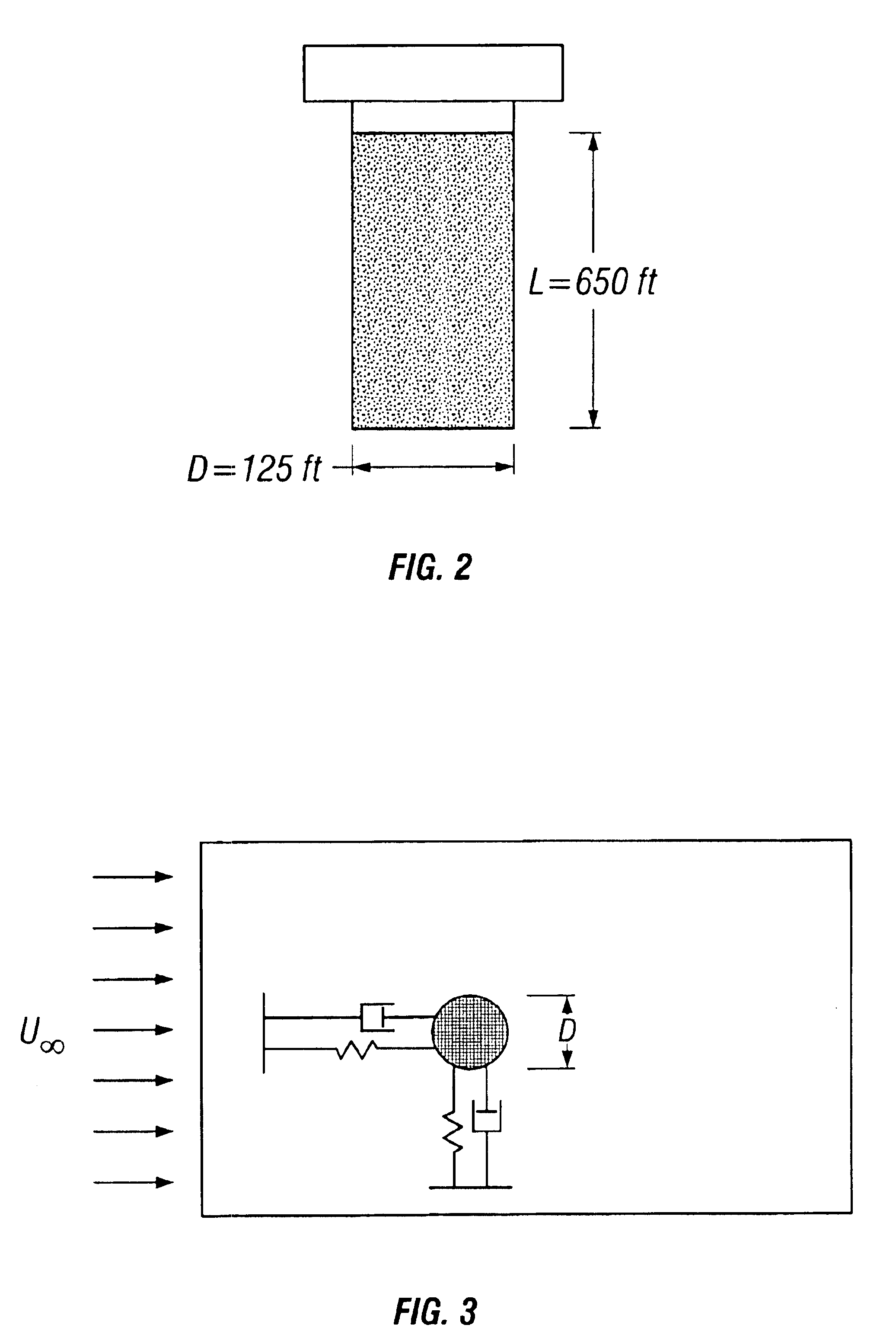Thruster apparatus and method for reducing fluid-induced motions of and stresses within an offshore platform
a technology of thruster and offshore platform, which is applied in the direction of vessel construction, transportation and packaging, foundation engineering, etc., can solve the problems of low-frequency oscillation, the vibration of the structure by the vortex,
- Summary
- Abstract
- Description
- Claims
- Application Information
AI Technical Summary
Benefits of technology
Problems solved by technology
Method used
Image
Examples
example 1
Re=104
Transverse Motions
[0105]After trial and error, the appropriate maximum value of the thrust coefficient CT was found to be (CT)max=0.15 (non-dimensionalized). The most conservative assumption (assumption A) was used to convert the thrust coefficient into a three-dimensional force. With this controller, the horizontal motions exhibit maximum transient displacement values equal to 80% of the spar diameter, and steady-state values of around 5% of the diameter. FIG. 7 shows the transverse displacement of the spar as a function of time. The required thrust coefficient CT as a function of time is shown in FIG. 8. This should be compared to typical steady-state values for spars with helical strakes of around 35% (per Don Allen, Shell). At the outset of this investigation, performance at least comparable to that for straked spars was being sought. For this very complex, nonlinear problem, it was observed that thruster forces (power) necessary to achieve “control” of VIV insured respon...
example 2
Re=4.25 105
[0118]The numerical simulations as discussed above were repeated at a Reynolds number Re=4.25 105. This Reynolds number was chosen because of the availability of earlier experimental results. It was found that the thruster configuration with (CT)max=0.15 was unable to control the motions. The simulations were repeated with a larger (CT)max ((CT)max=0.3) and in this case the thruster was able to adequately control VIV motions. In these simulations, the more conservative assumption A was used, that is the thrust coefficient was assumed constant over the spar depth.
[0119]The same case was repeated under assumption B, as stated earlier, that over the bottom third of the spar the current has decayed to zero therefore the bottom third of the spar contributes no VIV force and acts as a damping mechanism. Under this assumption, the thruster configuration with (CT)max=0.15 was able to control the motions with steady-state amplitudes around 8% of the spar diameter. The transverse ...
examples 1 and 2
Conclusions
[0120]Of the four different classes of controllers modeled: D-Controllers (proportional differential); Modified D-Controllers; Logic-Based Controllers; and Clipped D-Controllers, the clipped D-controller was preferred.
[0121]This clipped D-controller included logic for clipping the thrust output to a predetermined maximum value and for shutting down the thruster when the vibrations were below a certain minimum threshold.
[0122]The numerical simulations were performed at two different Reynolds numbers. The numerical results from the Re=104 simulations indicate that the spar VIV motions can be controlled with a thrust coefficient value (CT)max=0.15.
[0123]A number of additional numerical experiments were then carried out at this Reynolds number. Some of the different issues identified and explored include: Current Buildup Scenario; Delayed Motion Detection Scenario; Controller Performance-Sensitivity to Maximum Thruster Value, and Sensitivity to Shutoff Minimum Value.
[0124]The...
PUM
 Login to View More
Login to View More Abstract
Description
Claims
Application Information
 Login to View More
Login to View More - R&D
- Intellectual Property
- Life Sciences
- Materials
- Tech Scout
- Unparalleled Data Quality
- Higher Quality Content
- 60% Fewer Hallucinations
Browse by: Latest US Patents, China's latest patents, Technical Efficacy Thesaurus, Application Domain, Technology Topic, Popular Technical Reports.
© 2025 PatSnap. All rights reserved.Legal|Privacy policy|Modern Slavery Act Transparency Statement|Sitemap|About US| Contact US: help@patsnap.com



